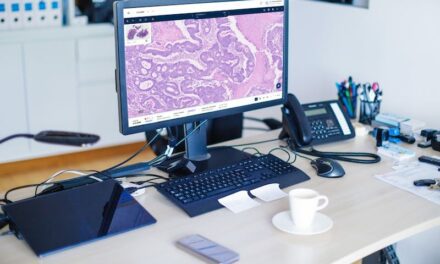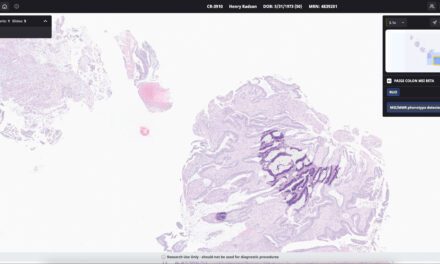Digital pathology software provider Proscia, Philadelphia, has released DermAI, the first in its series of artificial intelligence (AI)-based applications that advance the practice of pathology. A module on Proscia’s Concentriq platform, DermAI leverages deep learning to prescreen and classify skin biopsies. The application helps to reduce costly diagnostic errors and improve laboratory quality and efficiency, enabling labs to overcome the ongoing decline in the number of medical professionals entering the field of pathology.
The standard of care for diagnosing the 25 million skin biopsies taken in the United States every year has been based on a pathologist’s interpretation of patterns in tissue, as observed using a microscope. Proscia’s DermAI uses deep learning to read and automatically classify hundreds of variants of skin diseases into prediagnostic categories, in order to improve the confidence, quality, and speed of diagnosis.
“DermAI demonstrates a high level of accuracy in categorizing common diagnoses,” says Kiran Motaparthi, MD, assistant professor of dermatology at University of Florida College of Medicine. “As a dermatopathologist who seeks to prioritize and focus time on challenging cases, this is exciting technology.”
Proscia trained and tested the DermAI algorithm in a study using patient biopsies from leading academic and commercial dermatology laboratories, including Cockerell Dermatopathology, Dermatopathology Laboratory of Central States, Thomas Jefferson University Hospital, and the University of Florida. The multisite study validated the performance of DermAI using more than 20,000 patient biopsy slides. Proscia intends to submit a premarket notification (510(k)) to FDA, in order to get authorization for the use of DermAI in clinical diagnosis.
“To date, attempts to apply AI to pathology have been engineered in isolated development environments using toy datasets,” says David West, CEO of Proscia. “The challenge in fulfilling the promise of deep learning in diagnostic medicine is bringing to market a solution that can perform in the real world, where we face tremendous variability among labs, systems, and specimens.
“Proscia is the first to deliver on this promise,” adds West. “We could not be more delighted to be celebrating this industry milestone. Now, with our first proven solution on the market, we are able to scale out much of our intellectual property to accelerate the roll-out of additional disease-specific AI-based modules.”
Capabilities central to the DermAI offering include:
- Intelligent workload balancing and case prioritization. Enables the lab to sort, triage, and otherwise prioritize cases. This feature optimizes how cases are distributed to the various dermatopathologists in a lab—by subject matter expertise, by order of cases to examine, or even to create continuity so that investigators maximize their focus on high-impact cases.
- Automated quality control and 100% AI rereview. Analyzes a lab’s entire caseload, providing an AI-based interpretation for every case. Running in the background before and after the pathologist’s review, DermAI provides an automated second layer of quality review across the lab.
- Enhanced technical component reporting. Technical component (labwork) and professional component (diagnostic work) are billable services offered by anatomic pathology labs. DermAI allows a dermatopathology lab to provide additional insight into the labwork it delivers. This added value may guide doctors to understand when to let the lab handle diagnostic work and when to perform it in house.
The flexible nature of the DermAI software enables laboratories to take advantage of multiple use cases in a variety of configurations based on their current workflows, the preference of the pathologist, and the needs of their clients. DermAI also seamlessly integrates with most laboratory information systems (LISs), making the software easy to fit into existing lab processes.
“The true promise of digital pathology lies in deep learning, which will transform the practice of pathology for the first time since the introduction of the microscope,” says Thomas G. Olsen, MD, founder of Dermatopathology Laboratory of Central States, and an investigator in the DermAI validation study who collaborated with Proscia on the design and clinical requirements for DermAI. “It has been exciting to have been part of moving AI-enabled digital pathology beyond academic efforts and into real-world practice applications.”
For further information, visit Proscia.
Featured image: User interface of the DermAI dermatopathlogy module from Proscia.






